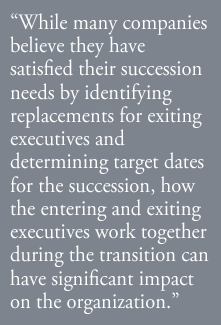
![]()
In today's business environment, with high executive mobility and frequent mergers and restructures, companies depend on smooth transfers of leadership from one executive to another for continued success. Both the company's objectives and the professional needs of leaders are best served when transfers are accomplished with minimum disruption to business processes and productivity.

While many companies believe they have satisfied their succession needs by identifying replacements for exiting executives and determining target dates for the succession, how the entering and exiting executives work together during the transition can have significant impact on the organization. Succession plans can be derailed when not enough attention is paid to the psychological makeup and personal agendas of the participating leaders. At the extreme, these situations provide leaders with an opportunity to play out personal issues on the stage of business operations, to the detriment of both the leaders' reputations and the organization's goals.
Providing executive coaching to the newly engaged executive facilitates his integration into the company and shortens the time required for him to get up and running. Executive Integration is a customized process designed to help executives avoid potential pitfalls and become effective leaders in a new environment. The process is relatively inexpensive and can save the company enormous costs in dollars, productivity, and morale.
![]()

The behavior of each participant in a transfer of leadership is influenced by his individual style and by the impact of the transfer on him. The exiting executive is relinquishing control and influence over an organization she may have invested years in building. She may be reluctant to let go and may want to maintain tight control until the final day. Conversely, if she is moving on to a more appealing situation, she may be eager to abandon leadership and to vacate her position quickly.
The entering executive has to prepare himself for a job he may be unsure he can succeed in. Whether his attitude is one of insecurity and hesitation, or of confidence and eagerness to move forward, he will have to be patient while he builds the knowledge base and relationship network that the new job demands.
There are many opportunities for frustrations to develop between the two leaders when their individual transition needs conflict. Even if the participants have a history of collaboration and shared vision, they may begin to mistrust each other's intentions and diminish their respect for each other's abilities.
![]()
Leadership transfers are most successful when the participating executives:
- Understand their individual professional needs and the forces that are affecting each of them during the transition period
- Recognize how these forces influence how they work together
- Avoid entanglement of personal issues in their actions and conduct
- Identify and address substantive issues impacting the transfer of leadership
- Work together to determine steps and rely on agreed-upon processes throughout the transfer period
![]()
Individual one-on-one meetings for each executive with the coach to:
- Determine personal needs and expectations
- Identify substantive and interpersonal issues impacting transfer of leadership
Joint meetings between the participants, facilitated by the coach, to:
- Define and record the exact goals and the steps to be followed in the transfer of leadership process
- Identify learning and development needs of the entering executive - for example, acquisition of critical information, inclusion at key meetings, etc. - which the exiting executive can provide
- Resolve interpersonal and substantive issues
- Create decision and problem resolution processes to be relied on during this stressful period
Third-party assessments to allow for the tracking of the transfer process.
Download a printable PDF of this page.
Back to top